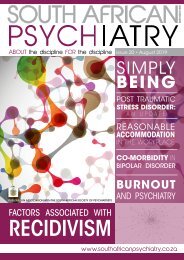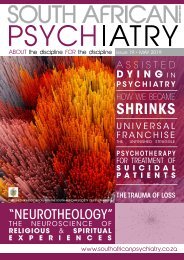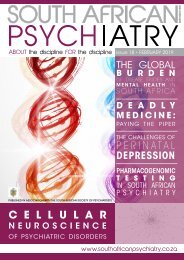South African Psychiatry - November 2018
South African Psychiatry - November 2018
South African Psychiatry - November 2018
You also want an ePaper? Increase the reach of your titles
YUMPU automatically turns print PDFs into web optimized ePapers that Google loves.
ORIGINAL<br />
EQUINE ASSISTED<br />
PSYCHOTHERAPY<br />
IN A SOUTH AFRICAN<br />
FORENSIC SETTING:<br />
A DESCRIPTIVE REPORT<br />
Marc Roffey a , Sarah Garland b , Fiona C. Bromfield c ,<br />
Nafisa Abdulla d , Rowdah Hawtrey e , Theoca Moodley f , Noeline Nune g<br />
a,d,e,f,g<br />
Valkenberg Hospital<br />
b,c<br />
The Equinox Trust<br />
ABSTRACT<br />
Equine Assisted Psychotherapy (EAP) is gaining much popularity as an intervention for a range of mental health<br />
problems. Although evidence for its efficacy has to date been low, this may largely be due to poorly conducted<br />
research. This article examines the evidence for EAP, and the indications for its use. It also explores its theoretical<br />
foundations and discusses an EAP project that has been conducted for four years at Valkenberg Hospital’s<br />
Forensic Mental Health Unit.<br />
The gracefulness, strength and agility of horses have long enthralled the human imagination, and the worlds<br />
of story-telling, myth and legend are richly populated with them. Although amongst the most beloved of<br />
domesticated animals, for millennia horses have been used as ‘beasts of burden’, and it has only been since the<br />
later years of the twentieth century that the therapeutic potential of working with horses has been formulated,<br />
explored, and researched. This article provides an overview of the discipline of equine assisted psychotherapy<br />
(EAP), which is emerging globally as an increasingly popular intervention for a range of mental health problems.<br />
It also describes an EAP project, now in its fourth year, which has been conducted at the forensic unit at<br />
Valkenberg Psychiatric Hospital, Cape Town.<br />
ANIMAL ASSISTED THERAPY<br />
By way of introduction, EAP can be understood within the larger construct of animal assisted therapy (AAT).<br />
Many people, especially pet-owners and animal-lovers, have an intuitive understanding of the potential benefits<br />
of being in the presence of, and interacting with, domesticated animals. AAT is the intentional inclusion of an<br />
animal into a therapeutic setting or intervention. Probably the best-known example is the therapy or service dog<br />
that is often used by people with physical disabilities. Other animals that are used in AAT include cats, guinea<br />
pigs, rabbits, fish, horses and birds, and typical settings include nursing, rehabilitation and elderly care facilities,<br />
hospices, correctional facilities, psychiatric and paediatric wards, homeless shelters and, on occasion, disaster<br />
scenes. 1<br />
SOUTH AFRICAN PSYCHIATRY ISSUE 17 <strong>2018</strong> * 7

















